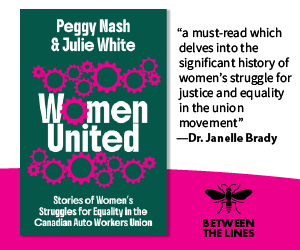Canadian Idle?

Illustration by Ted Barker
Inflation is spiraling out of control in Canada. A huge ego-bubble has developed on Sussex Drive and Bay Street, where chests have been expanding dangerously with every new media report extolling Canada’s success in weathering the global economic storm. First, there was Fareed Zakaria’s laudatory article in Newsweek, followed by Paul Volcker’s call for a banking model that “looks more like the Canadian system than the American system.” And then there was Obama’s visit to Ottawa, during which he reportedly told Harper he was thinking of changing his next campaign slogan to “Yes, we can…ada.”
These head-swelling endorsements from south of the border are inducing an uncharacteristic cockiness among Canadians. “Why not emulate the best in the world, which happens to be right next door?” crowed the National Post’s Theresa Tedesco in a New York Times op-ed. Chronic American inattention to matters Canadian had been chipping away at our national self-esteem over the years, but now regular praise from our southern neighbors is putting a wagger in our stride. It’s also giving our Prime Minister yet another opportunity to bask in the self-generated glow of his enlightened stewardship. Already a relentless promoter of Canada’s emerging energy superpower status, Stephen Harper can now trumpet Canada’s latest export: sound advice for the financially distressed around the world. It’s time to “put away that legendary Canadian modesty,” said Harper. Our banks should be seizing the opportunity to expand abroad, he implored, “to build the brand—the country’s brand, their own brand.” Canadians can finally look forward to a new national symbol to replace the RCMP: RBC.
Our Banks Robust, Theirs Go Bust
What was it that made our banks so resilient? Innovation? Risk-Taking? Competitiveness? It turns out our “comparative financial virtue comes from NOT having changed,” as one financial observer put it. Indeed, our banks have been able to strengthen their market position overnight by doing, well…nothing. It was our dearth of entrepreneurial spirit that saved us. For the secret to Canada’s success, in other words, look no further than our bank bored-rooms, where a combination of prudent lending and self-abnegation immunized our financial system from the contagion spread by those greedy Wall Street bankers. Thus has emerged the official narrative: Our banks are still afloat because there was only marginal engagement in what Paul Volcker called “highly risky entrepreneurial activities.” Known in banking circles as “innovative” finance, these were the reckless practices undertaken by the sorcerers of securitization that ended up contaminating the American banking system with toxic assets and creating the current credit crunch. Canada’s tighter regulatory structures, combined with a more risk-averse banking culture, prevented toxin levels here from rising uncontrollably. Conservative values, modest pecuniary ambitions, and good old-fashioned common sense ruled the day. We were even rational in our exuberance. How utterly dreary-dull! How typically Canadian! We didn’t really outsmart the financial wizards on Wall Street after all. We were just being typically Canadian: reserved, restrained, responsible. Rather than waste time constantly trying to create a Canadian version of Extreme Makeover, it is now trying to syndicate “Canadian Idle.” With the proper marketing, it hopes this new series will become more popular than Fear Factor, which has been hogging subprime time lately.
Canada’s Shadow Banking System
With U.S. competitors shrinking, our banks are now moving up North American rankings. Four of Canada’s Big Five are now among the top ten banks in North America; only RBC made the list last year. But in the rush to high five the Big Five, Canada’s other banks have been overlooked. I’m referring, of course, to our food banks, which are thriving. Yet our government will probably not be casting them in any roles in “Canadian Idle.” That’s because the Tories want to deflect attention away from the real economy, which is what matters most to Canadians. And in the real world, the indicators are nothing short of calamitous. The economic carnage has so far claimed 387,000 full-time jobs, and some project the unemployment rate to hit 12 percent next year. With only 42 percent of Canada’s unemployed workers receiving unemployment insurance today—compared to 78 percent in 1989—interest in food bank stocks is expected to accrue. On the other hand, purchasing these stocks might be increasingly difficult. In a recent study, economist Armine Yalnizyan has pointed out that the last time the personal savings rate in Canada hit such a low point was the late-1930s. The ratio of household debt to disposable income, according to consulting firm Deloitte & Touche, is now 130 percent—surpassing for the first time that in the U.S. Outstanding credit card balances have increased 40 percent since 2004, a jump of $80 billion. Delinquencies have doubled to 10 percent in the past few months, and Forbes warns that banks “could be on the hook for more than C$800 million ($656 million) in bad credit card debt in 2009.” Personal bankruptcy filings in Canada jumped 50.6 percent in December compared to the previous year. Alberta and British Columbia are experiencing a spike in foreclosures, and mortgage delinquencies are rising, according to an IMF report released in March.
If It Walks Like a Canuck…
These awkward intrusions of reality are threatening to undermine the integrity of the Canadian brand and ground the pilot for the “Canadian Idle” series. Increasingly concerned about this problem, our government has started producing vignettes intended for commercial breaks. One of these centers on the message that Canada’s major financial institutions have not yet needed “bailouts.” Word is that David Copperfield was initially approached to produce the vignettes, but he backed down when he realized the magnitude of the illusion involved. The Tories instead turned to the Semantics Division of the Finance Department, which has spun out the “Extraordinary Financing Framework” to try to disguise what economist Duncan Cameron rightly calls a “callous cash grab” on the part of the banks. The major component of this bailout, er, “framework,” according to the Financial Post, involves “[swapping] a sure thing: a large chunk of liquid and non volatile AAA-rated government debt, for a slew of ‘other’ assets whose nature remains uncertain to everyone but bank insiders, assets which are inherently more volatile and less liquid than government debt.” These mysterious “other” assets comprised about 42 percent of the bank’s assets in December 2008, compared to a minuscule 0.4 percent three months earlier. By the end of March this year, the government had bought $54.94 billion worth of these illiquid bank-held mortgage assets. Ottawa has also created a $12-billion credit facility to purchase asset-backed securities backed by loans and leases on vehicles and equipment. To help it disburse the funds, the federally owned Business Development Bank of Canada has recruited a top-notch financial expert with unerring judgment and unassailable integrity: a veteran Bay Street banker who played an instrumental role in creating the credit crisis in Canada. The other unacknowledged form of government “assistance” involves the overhauling of regulations to accommodate the banks. Thanks to a major change introduced by Canada’s Accounting Standards Board, for example, our banks have been able to avoid a multi-billion-dollar writedown. Also benefiting from the loosening of government regulations is Manulife, one of the pillars of Canada’s financial system. Its capital requirements were significantly relaxed after its CEO, Dominic D’Alessandro, showed up at the door of the Office of the Superintendent of Financial Institutions, cup in hand. Falling demand for Canada’s commodities may put even more pressure on the government to prop up the financial sector. As Ian de Verteuil of BMO Capital Markets has recently pointed out, for example, the 10-billion in bank financing that enabled Teck-Cominco to acquire Fording Canadian Coal could be in jeopardy because global demand for steel has dropped precipitously. All of Canada’s Big Five banks have significant exposure. To salvage the “Canadian Idle” pilot, scriptwriters will thus have to work much harder to produce a show compelling enough to accommodate all these deviations from the official narrative. Otherwise, each episode is going to be about as plausible as a rerun of Fantasy Island. The biggest challenge for scriptwriters will be to find a way to fudge the real reasons for the resilience of the Canadian banking sector. This will require more legerdemain, since the record is straightforward: It’s not so much “prudence” as “collusion” that accounts for the relative strength of our banks. And our government has not been “regulating” our banks as much as “protecting” them from serious competition. The big five in Canada—RBC, TD Canada Trust, Bank of Montreal, Scotiabank, CIBC—have long controlled the bulk of the country’s commercial and investment banking, credit card and mutual fund businesses. Their heft and political connections have enabled them to muscle out the competition and engage in synchronized gouging. The five members of the cartel treat “20 million Canadian bank customers pretty much however they want [and] do whatever they want with Canadians’ money,” as Duff Conacher, Coordinator of Democracy Watch, puts it. Benefiting from a protected market, they have been able to generate vertiginous piles of cash without having to take risks or worry about unfriendly takeovers. Banks, though, would have us believe it was their boy scout behavior that kept them out of trouble. Gordon Nixon, CEO of RBC, has been peddling the fiction that Canadian banks resisted pressure “to be more aggressive in expanding into international markets, particularly the United States…partially because of a more conservative approach.” David Haglund, a professor of international politics at Queen’s University in Kingston, believes modest pecuniary ambitions kept our banks out of trouble: “The difference with Canadian banks is that they never succumbed to the temptation of huge profits.” The Gandhian asceticism practiced by our banks is indeed praiseworthy. In 2006, their profits were a meager $19 billion. CIBC limped through 2007with a mere $3.3 billion in profits, Bank of Nova Scotia earned a paltry $4.05 billion, and RBC eked out a sparse existence with $5.49 billion. The same year, Canada’s top five banks were all listed among the top 35 banks in the world in terms of profits as a percentage of revenues, and profits as a percentage of assets. The following year, banks were barely able to scrape up enough cash to keep their CEOs out of the poorhouse. In the case of Bank of Montreal CEO Bill Downe, that would be $6 million in compensation in 2008. Contra Gordon Nixon, the banks have not been able to extract these obscene sums from Canadians’ wallets by remaining passive. The banking lobby has regularly swatted down efforts to regulate credit card rates, for instance, or to force disclosure of how fees and prices are determined. Whenever Finance Minister Jim Flaherty politely asks banks if they wouldn’t mind just once justifying their fees, he is politely told to mind his own business. Naturally, being a polite people, Canadians will probably continue to say “thank you” after receiving money from their ATMs…as long as they are kept in the dark about the $420 million a year they are charged to use them. Gordon Nixon’s bold claim that our banks have shied away from aggressively expanding into other markets also belies the evidence. John Cleghorn, RBC’s former CEO, wanted to buy BMO and its Chicago-based Harris Bank, and use it as “the launch pad for expansion into the United States.” Although the plan was ditched, RBC has spent $5 billion to strengthen its presence in the U.S. Last September RBC announced a $1.6 billion acquisition in Alabama. It plans to generate half of its revenue from non-Canadian sources in the next five to 10 years. All the other big banks have been expanding with equal, if not more, vigor. TD, for example, has spent $15 billion in the past four years extending its network of American branches. As for their ostensible aversion to “innovative finance,” the Big Five have been anything but chaste. So far, they have written off nearly $20 billion as a result of exposure to toxic assets. One enthusiastic participant in the trafficking of subprime slime was CIBC, which has had to write off $9.3 billion. It wouldn’t be the first time this proudly Canadian institution succumbed to the lure of easy money. As Diane Francis reminds us, the bank has been “at the forefront of virtually every major financial scandal,” including the Enron fiasco, which cost it US$2.4 billion in payouts to shareholders. All of our banks rode the tech and telecom boom of the late 1990s, doling out generous loans to companies like Nortel Networks in Canada and Global Crossing Ltd. in the U.S. Compared to the U.S., subprime lending is a small part of the mortgage market, but “there are more subprime mortgage borrowers in Canada than are recognized,” reports the Globe and Mail. In fact, from $3 billion to $5 billion worth of subprime mortgages will be coming up for renewal over the next four years. According to the Globe and Mail, “Canadian banks are showing very large increases in their provisions for bad loans, a sign that they expect deterioration in their core lending businesses.” And let’s not forget the Caisse de dépôt et placement du Québec (the Quebec Deposit and Investment Fund), which just posted its biggest loss in 43 years. The reason? It decided that pursuing the highest possible returns on the financial markets should trump promoting economic development in Quebec. The Caisse blew close to $40 billion after gambling with high-risk securities. Of course, now that financial “innovation” has been exposed as a giant Ponzi scheme, our banks are playing down their risky practices, while at the same time boasting that it was their prudence, responsibility and conservatism that saved them…and us. As a reward for their good behavior, they are now asking the government to pay more attention to their special needs by showing more “regulatory flexibility.” And just what does “flexibility” mean? “A more flexible regulatory system,” in the words of the Canadian Bankers Association, is one that can “help competitiveness by enhancing the ability of [financial] firms to be responsive to changing market opportunities.” It is one that allows our banks “the full range of options available to financial institutions in other jurisdictions” and removes the “restraints” not found elsewhere. And who better to ask for regula-tory relief than the Conservatives? Canadian banks, for their part, will need to “adopt a more aggressive approach,” if they are going to take on the other banking bullies, says Rick Waugh, chief executive of the Scotiabank Group. The message to the government could not be clearer: remove the obstacles to bank mergers and let our prudent banks become as big and mavericky as Citigroup. And throw in even more tax breaks while you’re at it. In fact, the Big Five have been haranguing the Ontario government for $2.5-billion tax cut…undoubtedly because they foresee difficulties paying their CEOs again. This does not augur well for the “Canadian Idle” series. What’s happening here doesn’t look that much different from what’s going on elsewhere. Our government has been responding to the economic crisis just like every other, raiding the public treasury and rewriting regulations to keep the banksters in business. Our financial institutions are no less focused on the bottom line than anywhere else. So, perhaps the government should shelve the idea for the new Canadian reality show. The plot has been overdone, and the ending is all too predictable.
This article appeared in the July/August 2009 issue of Canadian Dimension (The queer issue).









